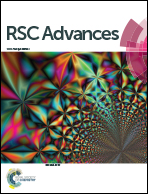Isotype heterostructure of bulk and nanosheets of graphitic carbon nitride for efficient visible light photodegradation of methylene blue
Abstract
Nanosheets of g-C3N4 were prepared by the ultrasonic treatment of aqueous dispersed bulk C3N4 for 10 h. The nanosheets have a comparatively larger surface area (121 m2 g−1) than that of bulk C3N4 (18 m2 g−1). Bulk C3N4 prepared by direct heating of urea has a band gap of 2.74 eV, whereas the nanosheets of g-C3N4 exhibited an enlarged band gap of 2.97 eV. The isotype heterostructure is fabricated by the solid-state mixing of bulk and nanosheets of C3N4 followed by ultrasonic treatment for dispersion. The heterostructure shows an effective band gap of 2.62 eV with an average charge carrier lifetime of 21 ns, which is longer than that of the bulk (13.2 ns) or nanosheets (17.4 ns) of g-C3N4. The heterostructure exhibits significantly higher visible light photocatalytic activity in the degradation of methylene blue (MB) over bulk or nanosheets of g-C3N4. The superior photocatalytic performance of the heterostructure is ascribed to band-bending at the interface that promotes molecular exciton dissociation and facilitates facile separation of charge carriers at the interface. From the results of photocatalysis, it is speculated that the photogenerated ˙OH radicals in conjunction with ˙H atoms take part in photocatalysis by N-deethylation followed by aromatic ring cleavage of the MB molecule.


 Please wait while we load your content...
Please wait while we load your content...